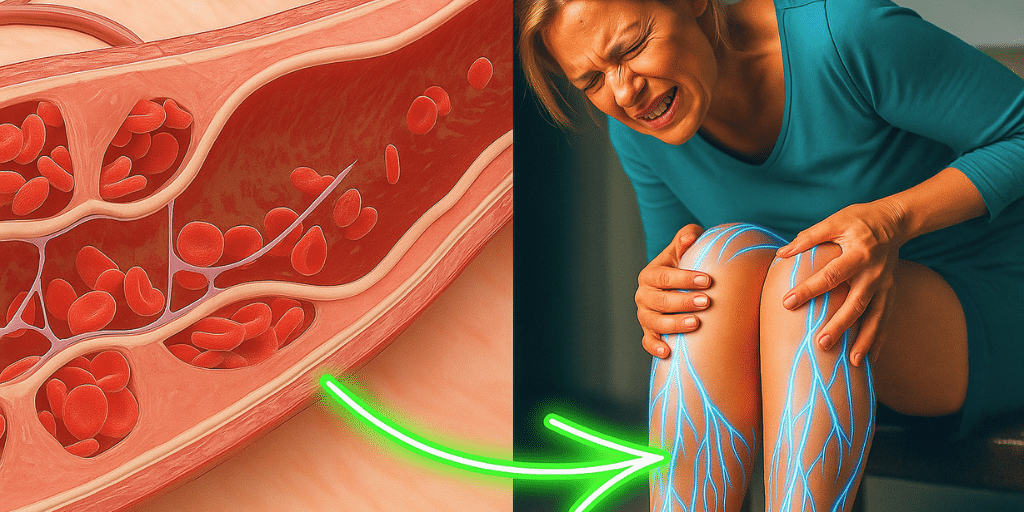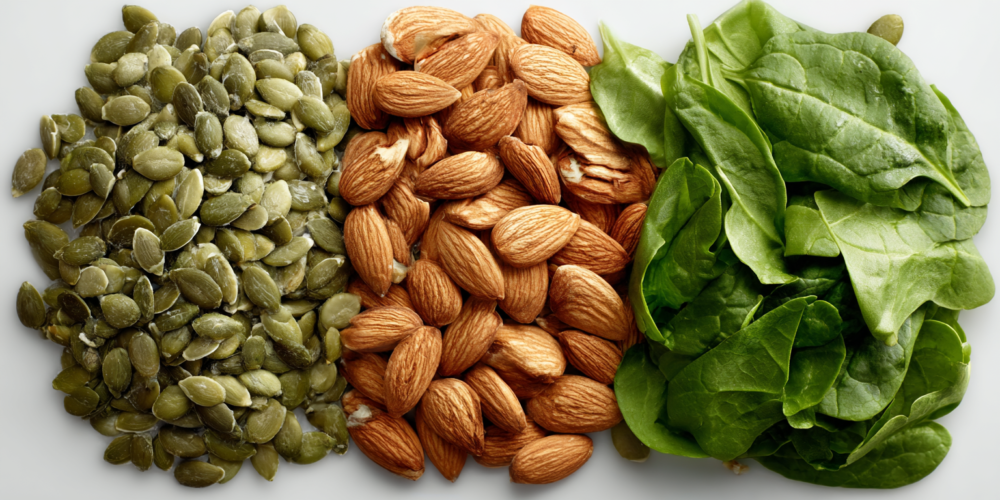
Do your legs feel heavy, swollen, or plagued by cramps at the end of the day? It’s easy to dismiss these as minor annoyances, but your body is sending you critical signals that something is wrong with your blood flow. The real problem, however, is often much deeper than you think. There are seven hidden reasons behind these symptoms, and one of them is a silent enemy lurking in your own kitchen—something you might be consuming every single day without realizing its devastating impact.
This common culprit is so pervasive that you wouldn’t even suspect it’s weakening the very foundation of your veins. You see, those foundations are built from collagen, a protein that requires a specific, essential nutrient to form correctly. Without it, you’re trying to build a house without cement. This article will walk you through the seven key saboteurs of your leg circulation, from nutritional deficiencies to simple habits you’ve overlooked. By understanding these factors, you can take back control and restore lightness and vitality to your legs. (Based on the expertise of Dr. Iñigo Martín)
Key Takeaways
- Nutrient Foundations: Your circulation depends on key vitamins and minerals. Vitamin C builds strong vein walls, Magnesium relaxes blood vessels to prevent cramps, and Vitamin K2 directs calcium away from your arteries.
- The Kitchen Enemy: Refined flours and added sugars are a primary cause of chronic inflammation and arterial damage, actively working against your efforts to improve circulation.
- Your Body’s Built-in Pump: Your calf muscles act as a “second heart.” Inactivity causes blood to pool in your legs, but simple exercises like calf raises can dramatically improve blood return to the heart.
- Preparation Matters: How you cook your food can either preserve or destroy the very nutrients your circulatory system needs. Simple changes like steaming instead of boiling can make a huge difference.
- The Power of Movement: Walking is one of the most powerful tools for boosting circulation, as it stimulates the production of nitric oxide, a natural vasodilator that relaxes and widens your arteries.
7. Your Veins Are Missing Their ‘Cement’: Vitamin C Deficiency

The very structure of your blood vessels relies on a protein called collagen. Think of collagen as the rebar and cement that gives your veins strength and elasticity. To manufacture this crucial protein, your body absolutely needs Vitamin C. Without enough Vitamin C, it’s like trying to build a sturdy wall with crumbling bricks. Your vein walls become fragile, weak, and easily dilated. The result? Varicose veins, which are a visible sign that the underlying structure is failing.
When you eat a raw red bell pepper or a kiwi, you’re giving your body the raw materials to build strong, resilient venous walls. But Vitamin C does more than just build; it also protects. Your arteries are under constant attack from free radicals, which damage the delicate inner lining called the endothelium. Vitamin C acts as a powerful antioxidant, a shield that protects this lining from daily oxidative stress. So, adding broccoli (steamed for just a few minutes) to your meal not only strengthens the structure of your veins but also defends them from damage. The best sources are often surprising: just half a cup of raw red bell pepper contains more Vitamin C than three oranges. Other excellent sources include kiwis, guavas, and lightly steamed broccoli.
6. Your Arteries Can’t Relax: Magnesium Deficiency

While Vitamin C builds the foundation, another mineral controls whether your blood vessels can relax or remain as tense as a guitar string. That mineral is magnesium, often called the “mineral of relaxation.” What’s the clearest sign you’re deficient? Those sudden, excruciating nighttime leg cramps that jolt you awake.
Magnesium acts like a master switch for your blood vessels. When you have enough, the smooth muscle walls of your arteries relax, allowing blood to flow freely. It’s the difference between a congested city street and a wide-open highway. Without sufficient magnesium, everything tenses up. Your arteries constrict, blood flow is hindered, and your legs feel the consequences at the end of the day. Those midnight calf cramps aren’t random; they are your body screaming for magnesium. This mineral governs the contraction and relaxation of every muscle, and when it’s lacking, your calf muscles can go into uncontrolled spasms. This constant tension has another effect: it makes it harder for blood to travel back up to the heart. If your veins are flexible hoses, they rely on the surrounding muscles to contract and relax, pumping the blood upward. If those muscles are perpetually tight from a lack of magnesium, it’s like pinching the hose. Flow is reduced, blood pools, and you feel that all-too-familiar heaviness. The modern lifestyle is a major culprit; stress, coffee, and alcohol all deplete your magnesium stores, while processed foods barely contain any. To fight back, incorporate spinach, almonds, and pumpkin seeds into your diet. A mere quarter-cup of pumpkin seeds provides about a third of your daily needs.
5. You’re Fueling a ‘Silent Fire’: Refined Flours and Sugar

Here is the silent enemy I mentioned, hiding in plain sight in foods we consider normal, even “healthy.” Refined flours and added sugars—the white bread for your sandwich, the pasta for dinner, the afternoon cookies, the soda—are sabotaging your circulatory health. The first problem is inflammation. Every time you eat white bread or drink a sugary beverage, your body reacts by creating a low-grade, chronic inflammation. You don’t feel it immediately, but inside your arteries, a slow fire begins to burn, day after day, making your vessel walls rigid and inelastic.
The second blow comes from glucose spikes. Refined carbs cause your blood sugar to skyrocket. This excess glucose directly attacks the endothelium, that protective inner layer of your blood vessels. It’s like pouring a mild acid on a delicate surface. But it gets worse. A process called glycation occurs when too much sugar is in your blood. The sugar molecules literally stick to proteins, including the collagen in your blood vessels, essentially caramelizing your arteries from the inside out. The collagen becomes hard and brittle, losing its natural flexibility. Your vessels turn into rigid pipes that can’t expand or contract properly. The issue isn’t the occasional birthday cake; it’s the constant, daily assault. While you’re diligently taking Vitamin C and magnesium, these sugars and flours are undoing all your hard work. It’s like trying to fill a bucket with holes in it. The solution starts with reading labels. Sugar hides under many names (dextrose, maltose, corn syrup). Switch to true whole grains, legume-based pastas, and brown rice, and prioritize cooking with simple, recognizable ingredients.
4. You’ve Forgotten Your ‘Second Heart’: The Inactive Calf Pump

Your body has an amazing, built-in tool to help circulation that you’re probably not using: the calf muscle pump. Think of it as a “second heart” located in your legs. Every time you contract your calf muscles, you squeeze the deep veins in your legs, forcing blood upward toward your heart against the pull of gravity. It’s like squeezing a tube of toothpaste from the bottom.
The problem is our modern, sedentary lifestyle. We spend hours sitting at a desk, standing still, or lying on the couch. During this time, the pump is inactive. Blood pools in the lower legs, the veins dilate under the weight of the stagnant fluid, and by evening, you feel that familiar heaviness and see the swelling. The solution is so simple it’s almost hard to believe: calf raises. Simply stand up, rise onto your tiptoes, hold for a moment, and lower yourself back down. When you rise up, your calf muscles contract powerfully, compressing the veins and pushing blood upward. As you lower, the veins refill, ready for the next pump. You can do this anywhere—while waiting for your tea to brew, talking on the phone, or standing in line. Consistency is more important than intensity. Aim for 20 repetitions every hour or two rather than one intense session. This keeps the pump active throughout the day, and your legs will thank you for it.

